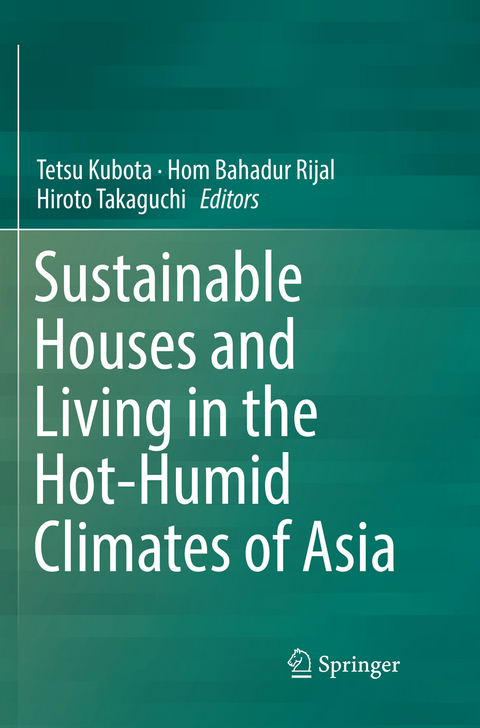
Sustainable Houses and Living in the Hot-Humid Climates of Asia
Springer Verlag, Singapore
978-981-13-4159-5 (ISBN)
Today, approximately 35-40% of global energy is consumed in Asia, and this percentage is expected to rise further. Energy consumption has increased, particularly in the residential sector, in line with the rapid rise of the middle class. The majority of growing Asian cities are located in hot and humid climate regions, and as such there is an urgent need for designers to provide healthy and comfortable indoor environments that do not consume non-renewable energy or resources excessively. This book is essential reading for anyone with an interest in sustainable house design in the growing cities of Asia.
Dr. Tetsu Kubota Hiroshima University, Higashi-Hiroshima, Japan Prof. Dr. Hom B. Rijal Tokyo City University, Yokohama, Japan Prof. Dr. Hiroto Takaguchi Waseda University, Tokyo, Japan
Preface.- 1. Introduction.- Part I Vernacular Architecture.- 2. Indonesia: Dutch Colonial Buildings.- 3. Malaysia: Malay House.- 4. Malaysia: Longhouse of Sarawak.- 5. India: Bio-Climatism in Vernacular Architecture.- 6. Nepal: Traditional Houses.- 7. China: Houses for Ethnic Minorities in Yunnan Province.- 8. Thailand: The Houses of a Khun Village in Chaing Mai.- 9. Laos: Indigenous Houses of a Lue Village in Luang Prabang.- Part II Adaptive Thermal Comfort.- 10. Principles of Adaptive Thermal Comfort.- 11. Thermal Comfort in Indonesia.- 12. Exergetic Aspect of Human Thermal Comfort and Adaptation.- 13. Thermal Sensation and Comfort in Hot and Humid Climate of Indonesia.- 14. Development of an Adaptive Thermal Comfort Equation for Naturally Ventilated Buildings in Hot and Humid Climates.- 15. Comfort Temperature and Preferred Temperature in Taiwan.- 16. Thermal Comfort in Indian Apartments.- 17. Comfort Temperature and Adaptive Model in Traditional Houses of Nepal.- 18. Comfort Temperature and Adaptive Model in Japanese Dwellings.- 19. Thermal Comfort Survey in Japan.- [Box] Thermal Comfort in Japanese and Indian Offices.- Part III Adaptive Behavior.- 20. Principles of Adaptive Behaviours.- 21. Behavioural Changes May Affect Changes in Comfort Temperature of Indonesian People.- 22. Window-Opening Behaviour in Hot and Humid Climates of Southeast Asia.- 23. Survey of Thermal Environment of Residences Using Air Conditioners in Surabaya, Indonesia.- 24. Occupants’ Behaviour in Taiwan.- 25. Occupant Behavior in Indian Apartments.- 26. Occupant Behaviour in the Various Climates of Nepal.- 27. Window Opening Behaviour in Japanese Dwellings.- 28. Occupants’ Climate-controlling Behavior in Japanese Residences.- [Box] Occupant Adaptation in Japanese and Indian offices.- Part IV Energy Consumption.- 29. The Use of Energy Consumption Data.- 30. Overview of Energy Consumption in Hot-Humid Climates of Asia.- 31. Energy Consumption and Indoor Temperature in Cambodian Houses.- 32.Analysis of household energy consumption and CO2 emissions for residential buildings in Jakarta and Bandung; A study of Indonesia.- 33. Firewood Consumption in Nepal.- 34.Thermal Environment and Energy Use of Houses in Bangkok, Thailand.- 35. Energy consumption of residential buildings in China.- 36. Household energy consumption in slum areas: A case study of Tacloban City, Philippines.- Part V Indoor Thermal Environment.- 37. Thermal Function of Internal Courtyards in Traditional Chinese Shophouses in Malaysia.- 38. Passive Cooling of the Traditional Houses of Nepal.- 39. Passive Cooling Strategies to Reduce Energy Consumption of Cooling in Hot and Humid Climate in Indonesia.- 40. Indoor Thermal Environments in Apartments of Surabaya, Indonesia.- 41. Indoor Thermal Environments from Vernacular to Modern Houses in Cambodia .- 42. Actual Condition of the Indoor Environment of Houses in Nine Chinese Cities.- Part VI Sustainable Houses in Asian Cities.- 43. Energy-Saving Experimental Houses in Malaysia.- 44. S-PRH in Kitakyushu, Japan.- 45. Eco-House in Kyusyu, Japan.- 46. Sustainable Houses in Japan: An Overview.- [Box] An example in Thailand: Floating in the Sky School for Orphans.- Part VII Climate Change and Urbanization.- 47. Climate Vulnerability in Tropical Asia.- 48. Urban Climate Challenges in Hanoi: Urban Heat Islands and Global Warming.- 49. Assessment of Future Urban Climate after Implementation of the City Master Plan in Vinh City, Vietnam.- 50. Urban Heat Island of Putrajaya City in Malaysia.
| Erscheint lt. Verlag | 11.2.2019 |
|---|---|
| Zusatzinfo | 201 Illustrations, color; 146 Illustrations, black and white; XVIII, 559 p. 347 illus., 201 illus. in color. |
| Verlagsort | Singapore |
| Sprache | englisch |
| Maße | 155 x 235 mm |
| Themenwelt | Naturwissenschaften ► Biologie ► Ökologie / Naturschutz |
| Naturwissenschaften ► Geowissenschaften ► Meteorologie / Klimatologie | |
| Sozialwissenschaften ► Politik / Verwaltung | |
| Schlagworte | Adaptive comfort • climate change • Developing Countries • Energy-Saving • exergy • green growth • household energy consumption • Occupants’ behaviour • Passive cooling • South Asia • Southeast Asia • sustainability • Thermal comfort • tropics • Urban Heat Island • Vernacular architecture • Window opening |
| ISBN-10 | 981-13-4159-1 / 9811341591 |
| ISBN-13 | 978-981-13-4159-5 / 9789811341595 |
| Zustand | Neuware |
| Haben Sie eine Frage zum Produkt? |
aus dem Bereich


